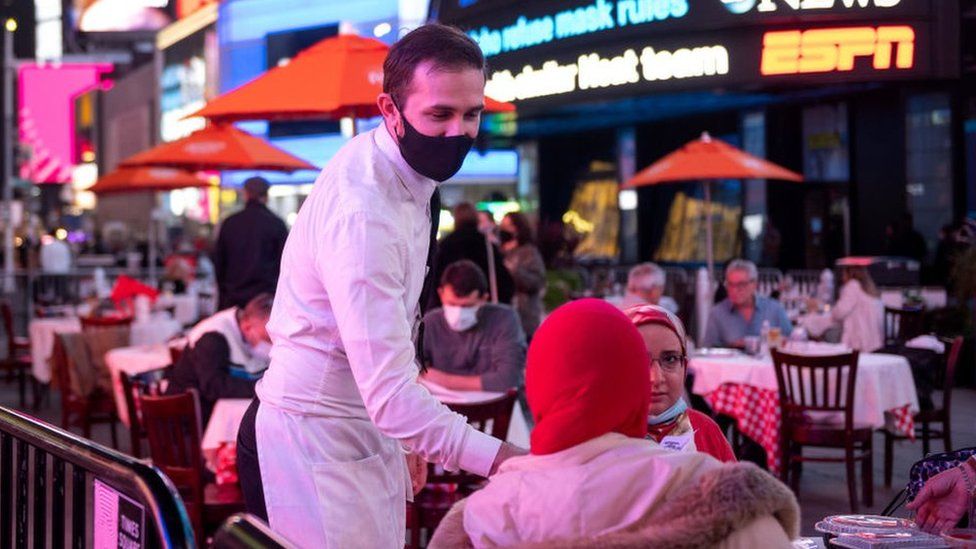
US jobs growth picked up speed in June as the economic reopening continued, official figures show.
Employers created a larger-than-expected 850,000 jobs last month, driven by new posts in bars and restaurants, retail and education.
Despite the boost in hiring, the unemployment rate was little changed at 5.9%, the US Bureau of Labor Statistics said.
It comes as different industries offer incentives to battle a worker shortage.
Although the number of job vacancies has seen a record high of 9.3 million, firms such as McDonald's and Chipotle in the hospitality industry, for example, have increased the minimum wages in their company restaurants to try to entice new staff.
The new monthly figures showed that average hourly earnings rose 0.3% last month after increasing 0.4% in May.
Although more than half of the jobs added in June were in leisure and hospitality, employment in those sectors is still down by about 2.2 million on pre-pandemic levels.
Positive signs
Despite that, some experts said the figures suggested a recovery was "well underway".
"Key for us was the fact that jobs gains were led by the services sector, signalling the strong positive momentum in these areas," said Xian Chan, chief investment officer of wealth management at HSBC.
"It also reminds us what a difference a year makes! In April last year, about 15% of people in the US were unemployed - a figure worse than the global financial crisis."
He said that in contrast, it now looks like there are not enough workers to fill vacant positions.
Surveys have suggested that some people are hesitant to re-enter the workforce because of healthcare risks, child-care issues and unemployment benefits.
Under the $1.9tn coronavirus rescue package that President Joe Biden signed into law in March, some workers can get a $300 weekly supplemental benefit if they are out of a job.
But at least 25 states have opted to cut unemployment benefits prematurely, so people are not persuaded to stay at home.
"With economic growth booming, labour demand is strong and job openings have risen to all-time highs," said John Leiper, chief investment officer at Tavistock Wealth. "Now it's just a case of letting supply catch up."

As part of its decision on when and how to tackle the rising cost of living, the Federal Reserve is monitoring unemployment and wage increases as supply in the labour market remains tight.
Mr Leiper added the better-than-expected June figures "make it more likely the Fed will pull back sooner, and with greater force, than currently anticipated."
Fed officials, including its chair Jerome Powell, have played down worries, saying that rising costs reflect "transitory factors" as the economy reopens.
He recently said it was important to continue support as the recovery from the Covid crisis is still underway.
"The economic downturn has not fallen equally on all Americans, and those least able to shoulder the burden have been hardest hit," he said in June.


It was certainly a strong figure for a single month's job gains as the US labour market continued to repair the damage done to it by the pandemic.
That was reflected in the large contribution from leisure and hospitality, industries that have been hit very badly and which are now responding to the easing of restrictions.
But there is still a long way to go. The number with a job, though much improved on last year's low, is still 6.8 million below its pre-pandemic peak. It is even further adrift of what it would have been without the health crisis as job growth would otherwise surely have continued.
The number of unemployed is also far below its worst, but is still higher than before the arrival of the coronavirus. Another important statistic is the number of people classified as not in the labour force, which covers people who don't have and are not seeking work.
Many of the 100 million or so Americans in that group are there because they want to be - they may be homemakers, students or retired. But many are not, some thinking the opportunities are not available.
The fact that the number is five million higher than at the start of last year is another indicator that the jobs recovery is far from complete.

https://news.google.com/__i/rss/rd/articles/CBMiLGh0dHBzOi8vd3d3LmJiYy5jby51ay9uZXdzL2J1c2luZXNzLTU3Njk3NjQ50gEwaHR0cHM6Ly93d3cuYmJjLmNvLnVrL25ld3MvYnVzaW5lc3MtNTc2OTc2NDkuYW1w?oc=5
2021-07-02 14:15:12Z
52781706968097
Tidak ada komentar:
Posting Komentar